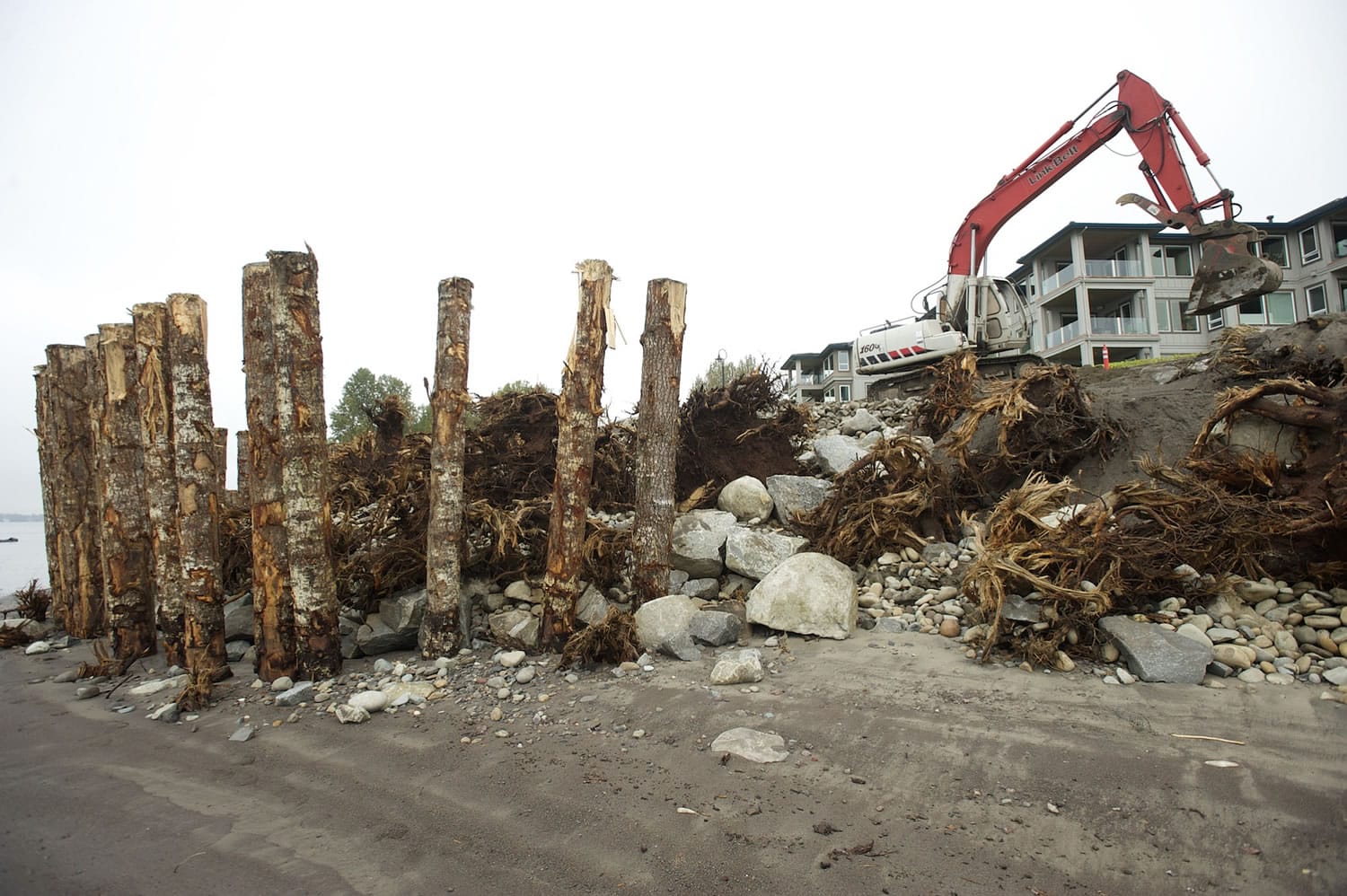When the flood-stage Columbia River ate into its northern bank near Tidewater Cove three years ago, the sandy slope went down smoothly.
The river will have to work harder if it returns for a second helping of the foundation for Vancouver’s popular Waterfront Renaissance Trail.
In January, when the public will once again have full access to the 5-mile-long trail, users will notice the slope near Tidewater Cove has a distinctly different look than the one that washed away.
The shoreline curves in and out, creating five sandbars to mimic a sixth natural one, and has been enhanced with large protruding Douglas fir root clumps fronted by 25-foot Douglas fir logs, which serve as piles, pounded about 16 feet deep.
The large, woody material provides a few advantages over just adding rock, said Charles Fell, a senior civil engineer in the city’s public works department.
“The root clumps slow and dissipate the flow of the river, decreasing the amount of erosion that occurs,” he said. “The relatively calmer water around the root clumps also provides habitat for migratory fish.”
The state Department of Ecology and U.S. Army Corps of Engineers, two of the permitting agencies, prefer large woody material over rock for riverbank and stream bank protection, Fell said.
Ridgefield’s Keystone Contracting, which this summer was awarded the contract to fix the western section of the damaged trail, has built several similar projects in Oregon using large woody material, including on the Willamette River, Johnson Creek and Sylvan Creek, Fell said.
Fell said Keystone usually buys the material from contractors and developers who need to remove trees along with stumps, such as when they are clearing land for a new subdivision or a road.
High winds Tuesday and Wednesday didn’t damage any of Keystone’s work, Fell said, but it has slowed it down. Crews are expected to start planting a mix of willow trees and native plants soon, and work should be finished by the end of the year. The work has to be done this time of year because of low river levels, Fell said.
Costly fix
Repairing the Waterfront Renaissance Trail has been a priority for the city council, said Vancouver Mayor Tim Leavitt.
“We’re elated to reopen our waterfront trail in the near future,” he said Wednesday. “Mother Nature certainly inconvenienced our waterfront enjoyment, but now we’re back in business.”
In the spring of 2011, snowmelt and heavy rain drove the Columbia River to its highest level in 14 years. Erosion left two sections of the 5-mile-long trail in the area of Tidewater Cove unsafe, and they were closed to the public. The sections had been built in 1999 by private developers and deeded to the city.
Since the washout, trail users have been detoured to Columbia Way.
Keystone was also awarded the bid for the eastern section of damaged trail through the city’s competitive bid process, in which the contract goes to the company with the lowest responsive bid.
Work on that section, which was done last fall, involved repairing about 80 horizontal feet of failed slope, reinforcing another 250 horizontal feet of slope, removing and replacing 170 feet of paved trail and adding thousands of plantings, including dogwood, willow trees and a mix of grasses.
In June, the city council appropriated money for the second section, which would have to be done in two phases.
At the time, Leavitt said spacing out the repair work serves as a great example of the delicate balancing act the city must do in prioritizing services with maintenance and repairs when there’s not enough money in the budget to do all of the work immediately. Other barriers to making immediate fixes were the time it took to secure permits from state and federal river regulators and the need to do the work during low-water season.
All of the money for trail repairs has come out of the city’s general fund, which pays for basic services such as police, fire and roads, as well as repairs to community asset.
The estimated cost of the entire project is $2.6 million, said Natasha Ramras, the city’s deputy finance director.
To save money, an old overlook isn’t being replaced.
Eleven companies submitted bids for the second section, ranging from $1.86 million down to Keystone’s winning bid of $1.19 million. The contract was awarded in August.
The first phase of work required the removal and replacement of about 700 feet in total trail surface and construction of “a slope-stabilizing, bio-engineered solution,” according to a Aug. 4 staff report prepared for the council by City Manager Eric Holmes. The second phase involved slope reinforcement, plantings and rock stabilization along about 650 feet of trail.
Fell said a total of about 2,400 plantings would be added below the trail to further stabilize the slope.
He said there will be 250 each of four types of native plants — ocean spray, pacific ninebark, Nootka rose and snowberry — and about 1,400 willow trees.



